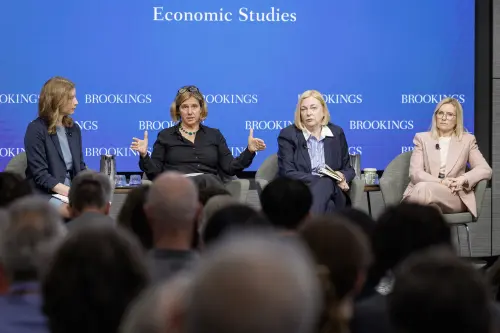To continue to grow in the face of declining and aging populations, high- and middle-income countries have three options: increase migration, use more automation, and retain and attract older workers into the labor force. Restrictions on the number of migrants countries are willing to absorb, and limits on the impact of automation on productivity in post-industrial economies make the third option the most economically and politically viable in many settings.
The world’s population is aging
Globally, the share of older people in the population is rising because of declines in fertility, increases in longevity, and the progression of large-sized cohorts to older ages. By 2050, one in four Europeans will be 65 or older. Life expectancy in developed countries has increased by about two years per decade over the last 200 years. As a result, children born in the 2020s have more than a 50 percent probability of surviving past the age of 100. People are not only living longer, they are also living healthier lives. Under the right policies, harnessing older workers could result in economy-wide productivity improvements, often referred to as longevity dividends.
Extended longevity comes at a cost. Having fewer working-age people slows capital investment and GDP growth. Declining worker-to-retiree ratios and more years in retirement put pressure on national social protection systems and push countries to raise the retirement age. Staged reforms of pension systems often result in overlaps between the retirement ages within the same age cohorts, creating uncertainty about retirement in long-term life planning.
Policy responses to a new multi-stage life model
The traditional three-stage (school, work, retirement) sequential life model is giving way to a more flexible multi-stage model where learning, leisure, work, and caring could take place across the whole life, better accommodating transitions during longer careers. Education acquired early in life may become obsolete. Changing jobs requires reskilling, and periods of physical and mental recovery may be needed to maintain productivity.
Social institutions dealing with older populations that now focus primarily on pensions, healthcare, and end-of-life care provision must respond to the new challenges. Changes in retirement age, pension entitlements, and contribution rates should be complemented by policies that help people manage their multi-stage lives and promote healthy and productive aging. New approaches to healthcare, labor market policies, and education will be crucial to allowing countries to achieve the full potential of longevity benefits.
The first challenge is to translate increased longevity into the extension of a productive and healthy life rather than add years of (high-cost) disability to the end of life. The goal is to reduce the risk and delay the onset of physical and cognitive disabilities and improve functional capacities if intrinsic abilities decline. Achieving this goal requires a major reallocation of resources in the health care system from treatment to prevention activities. Interventions with the greatest impact might not necessarily focus on old age but could target earlier stages of life, helping young people age better.
Four groups of factors will determine the success of healthy aging policies:
- Healthy behaviors, such as healthy diets and physical exercise, could be incentivized through public campaigns and economic incentives.
- Socioeconomic factors that cause health inequalities to widen with age could be addressed by policies targeting poor people who live less healthy lives compared to better-off people and also combined with public campaigns and economic incentives.
- Environmental policies aimed at reducing air pollution, improving sanitation, and optimizing urban planning.
- Research on the cellular and molecular processes associated with aging and the factors affecting the onset of age-related diseases promises to achieve substantial progress in healthy aging.
A virtuous circle of longevity, health, and productivity, in which productive engagement at older ages is associated with positive physical and mental health outcomes and could delay the onset of age-related illnesses, will reinforce the impact of healthcare interventions.
Recent growth in the labor force participation of older workers is attributed mainly to changes in social security and tax systems. Further increases in retirement age are politically challenging. Labor market policies should be redesigned to lower the costs of hiring and retaining older employees and make post-retirement work more attractive to older workers. On the demand side, strict employment protection combined with asymmetric information about the productivity and health status of older workers increase the costs of labor adjustment, thus reducing the incentives for the firms to hire and retain older workers. On the supply side, tax credits to older, especially low-skilled, workers could be effective in increasing their labor force participation. Work flexibility is one of the main factors that determines whether older workers continue working after retirement. Labor market legislation should support employees seeking more flexible work arrangements, including work hours, extended vacation time, and the ability to work remotely or in a hybrid fashion. While flexibility is good for the labor market in general, older workers might benefit the most from such policies. Practices such as “returnships”—internship-type periods during which retirees can temporarily return to assist on a particular task or project or to mentor younger workers (a la Robert de Niro in “The Intern”)—could increase the attractiveness of work for retirees. Labor regulations should also make it easier for older workers to work for themselves.
Deemphasizing formal educational requirements and prioritizing skills, competencies, and years of relevant experience could improve the labor-market prospects of many older workers. Skill-based hiring could overcome challenges older workers face stemming from the lack of traditional education or difficulty changing careers. For example, leading U.S. IT companies announced the elimination of degree requirements in their employment practices, with only 43 percent of Accenture’s and 29 percent of IBM’s postings positions containing degree requirements.
Multi-stage careers are less likely to occur when workers spend their entire careers working for a single employer. A new approach to career planning should consider the optimal timing of job transitions and the skills needed to play different roles. An education system that shifts from front-loaded to lifetime learning would help workers stay current and relevant in the labor market and help individuals navigate their career paths. The contribution of work experience and life-long learning to economic development might be as important as the contribution of education. And, while reform of the educational system is likely to be costly and slow, the costs of institutional reforms that improve returns to experience may be much lower and have a faster impact. Transitioning to such a system may require redistributing public investments to agencies providing formal and non-formal education to older people. The success of such reforms would require stronger policy coordination by the government, educational institutions, and firms to incentivize more effective investments in education and training at older ages. Establishing regulatory frameworks for private training provision would help overcome the rigidities of formal educational systems. By enhancing physical, social, and emotional well-being, lifelong learning can create a virtuous cycle for productive aging.
Policy needs to address inequality
Policy on productive aging also needs to address the issue of inequality. In the United States, the life expectancy of men from the top of the income distribution is about 15 years longer than that of men from the poorest percentiles. If the life expectancy of some groups continues to stagnate or even decline, a uniform and higher retirement age could eliminate retirement for poor people altogether.
Gender inequality in work participation at older ages is also significant. Older women’s caregiving responsibilities often make it impossible for them to participate in the labor force. Improvements in the provision and costs of elder and child care could increase the participation of older women in the labor market.
Educational inequalities at early stages of life translate to even greater inequalities in human capital at older ages. The benefits from lifelong learning in terms of employability and earnings at older ages increase with tertiary education. Maximizing longevity dividends requires addressing these inequalities through the development of institutions to support healthy, long, and productive lives for all.
The Brookings Institution is committed to quality, independence, and impact.
We are supported by a diverse array of funders. In line with our values and policies, each Brookings publication represents the sole views of its author(s).







Commentary
The challenges and promises of productive aging
September 7, 2023